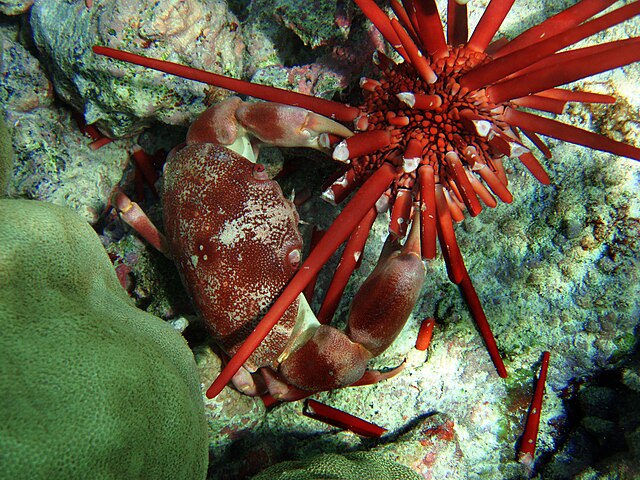Crab
infraorder of crustaceans From Wikipedia, the free encyclopedia
Remove ads
Crabs are a form of decapods (having eight walking legs and two grasping claws), along with lobsters, crayfish and shrimps. Crabs form an order within the decapods, called the Brachyura. Their short body is covered by a thick exoskeleton.

They are an extremely successful group, found all over the world. They are basically heavily armored shell-breakers. Most crabs live in sea-water, but there are some who live in fresh water, and some who live on land. The smallest are the size of a pea; the largest (the Japanese spider crab) grows to a leg span of 4 metres.[2] About 7,000 species are known.[3]
Remove ads
Structure and life-style
Body
Crabs have short tails. A crab's tail and reduced abdomen is entirely hidden under the thorax. It is folded under its body, and may not be visible at all unless the crab is turned over. Usually they have a very hard exoskeleton. This means they are well protected against predators. Crabs are armed with a single pair of claws. Crabs can be found in all oceans. Some crabs also live in fresh water, or live completely on land.
Pincers

The pincers (claws) of crabs are their most important weapons. They have at least three functions. The pincers' role in eating is to seize and subdue the prey. If the food is a shellfish (mollusc), then the pincers can exert force to open or break the mollusks shell. Pincers are also used in fighting between males, and for signalling to other crabs.
Diet
Crabs are omnivores, they eat almost anything they find. Often this is algae, but animal food is essential for its good health and development. They will eat molluscs, other crustaceans, worms, fungi and bacteria.[4][5]
Remove ads
Crabs as food
Crabs are prepared and eaten all over the world. Some species are eaten whole, including the shell, such as soft-shell crab; with other species just the claws and/or legs are eaten. In some regions spices improve the culinary experience. In Asia, Masala Crab and Chilli crab are examples of heavily spiced dishes. In the United States state of Maryland, blue crab is often eaten with Old Bay Seasoning.
For the British dish Cromer crab, the meat is extracted and placed inside the hard shell. One American way to prepare crab meat is by extracting it and adding a flour mix, creating a crab cake. Crabs are also used in bisque, a French soup.
Remove ads
Evolution
True crabs appear in the fossil record in the Lower Jurassic. They are part of the 'Mesozoic marine revolution', in which a number of sea-floor predators evolved.[6][7][8]
Tailpiece
The closest relatives of the crabs are anomurans, a crustacean group which includes animals such as hermit crabs, king crabs and squat lobsters. They look a lot like crabs and many have the word 'crab' in their name, but are not true crabs. Anomurans can be told apart by the number of legs: crabs have eight legs, along with two claws or pincers, while the last pair of an anomuran's legs is hidden inside the shell, so that only six are visible.
Cultural influences
Both the constellation Cancer and the astrological sign Cancer are named after the crab, and shown as a crab. William Parsons, 3rd Earl of Rosse drew the Crab Nebula in 1848 and noticed it looked like the animal; the Crab Pulsar lies in the middle of the nebula.[9] The Moche people of Peru worshipped nature, like the sea,[10] and often have crabs in their art.[11] In Greek mythology, Karkinos was a crab that helped the Lernaean Hydra while it was fighting Heracles. One of Rudyard Kipling's Just So Stories, The Crab that Played with the Sea, tells the story of a big crab who made the waters of the sea go up and down, like the tides.[12] A Malay myth, ocean tides are thought to be caused by water going in and out of a hole in the Navel of the Seas (Pusat Tasek), where "there sits a gigantic crab which twice a day gets out in order to search for food".[13]: 7–8
Remove ads
References
Wikiwand - on
Seamless Wikipedia browsing. On steroids.
Remove ads

